bulb TOYOTA RAV4 2019 Owners Manual (in English)
[x] Cancel search | Manufacturer: TOYOTA, Model Year: 2019, Model line: RAV4, Model: TOYOTA RAV4 2019Pages: 728, PDF Size: 21.09 MB
Page 1 of 728

1
2
3
4
5
6
7
8
9
10
Pictorial indexSearch by illustration
For safety
and securityMake sure to read through them
(Main topics: Child seat, theft deterrent system)
Vehicle status
information and
indicatorsReading driving-related information
(Main topics: Meters, multi-information display)
Before driving
Opening and closing the doors and windows,
adjustment before driving
(Main topics: Keys, doors, seats)
Driving
Operations and advice which are necessary for
driving
(Main topics: Starting engine, refueling)
Entune audioOperating the Entune Audio
(Main topics: Audio/visual, phone, Toyota Entune)
Interior featuresUsage of the interior features
(Main topics: Air conditioner, storage features)
Maintenance
and careCaring for your vehicle and maintenance
procedures
(Main topics: Interior and exterior, light bulbs)
When trouble
arisesWhat to do in case of malfunction and emergency
(Main topics: Battery discharge, flat tire)
Vehicle
specificationsVehicle specifications, customizable features
(Main topics: Fuel, oil, tire inflation pressure)
For ownersReporting safety defects for U.S. owners, and seat
belt and SRS airbag instructions for Canadian
owners
IndexSearch by symptom
Search alphabetically
Page 5 of 728
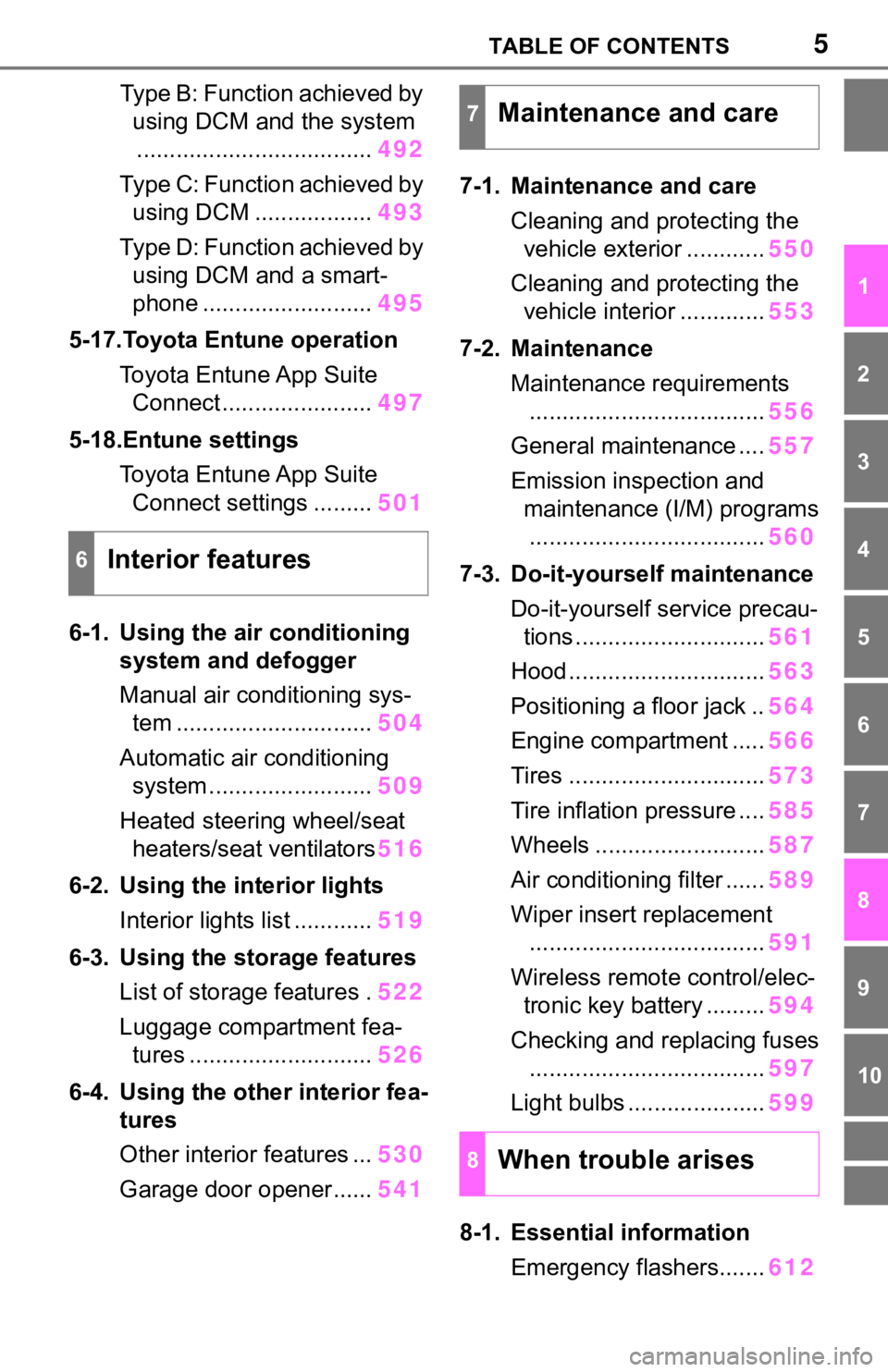
5TABLE OF CONTENTS
1
2
3
4
5
6
7
8
9
10
Type B: Function achieved by using DCM and the system
.................................... 492
Type C: Function achieved by using DCM .................. 493
Type D: Function achieved by using DCM and a smart-
phone .......................... 495
5-17.Toyota Entune operation Toyota Entune App Suite Connect ......... ..............497
5-18.Entune settings Toyota Entune App Suite Connect settings ......... 501
6-1. Using the air conditioning
system and defogger
Manual air conditioning sys- tem .............................. 504
Automatic air conditioning system ......................... 509
Heated steering wheel/seat heaters/seat ventilators 516
6-2. Using the interior lights Interior lights list ............ 519
6-3. Using the storage features List of storage features . 522
Luggage compartment fea- tures ............................ 526
6-4. Using the other interior fea- tures
Other interior features ... 530
Garage door opener...... 5417-1. Maintenance and care
Cleaning and protecting the vehicle exterior ............ 550
Cleaning and protecting the vehicle interior ............. 553
7-2. Maintenance Maintenance requirements.................................... 556
General maintenance .... 557
Emission inspection and maintenance (I/M) programs
.................................... 560
7-3. Do-it-yourself maintenance Do-it-yourself service precau-tions ............................. 561
Hood .............................. 563
Positioning a floor jack .. 564
Engine compartment ..... 566
Tires .............................. 573
Tire inflation pressure .... 585
Wheels .......................... 587
Air conditioning filter ...... 589
Wiper insert replacement .................................... 591
Wireless remote control/elec- tronic key battery ......... 594
Checking and replacing fuses .................................... 597
Light bulbs ..................... 599
8-1. Essential information Emergency flashers....... 612
6Interior features
7Maintenance and care
8When trouble arises
Page 15 of 728
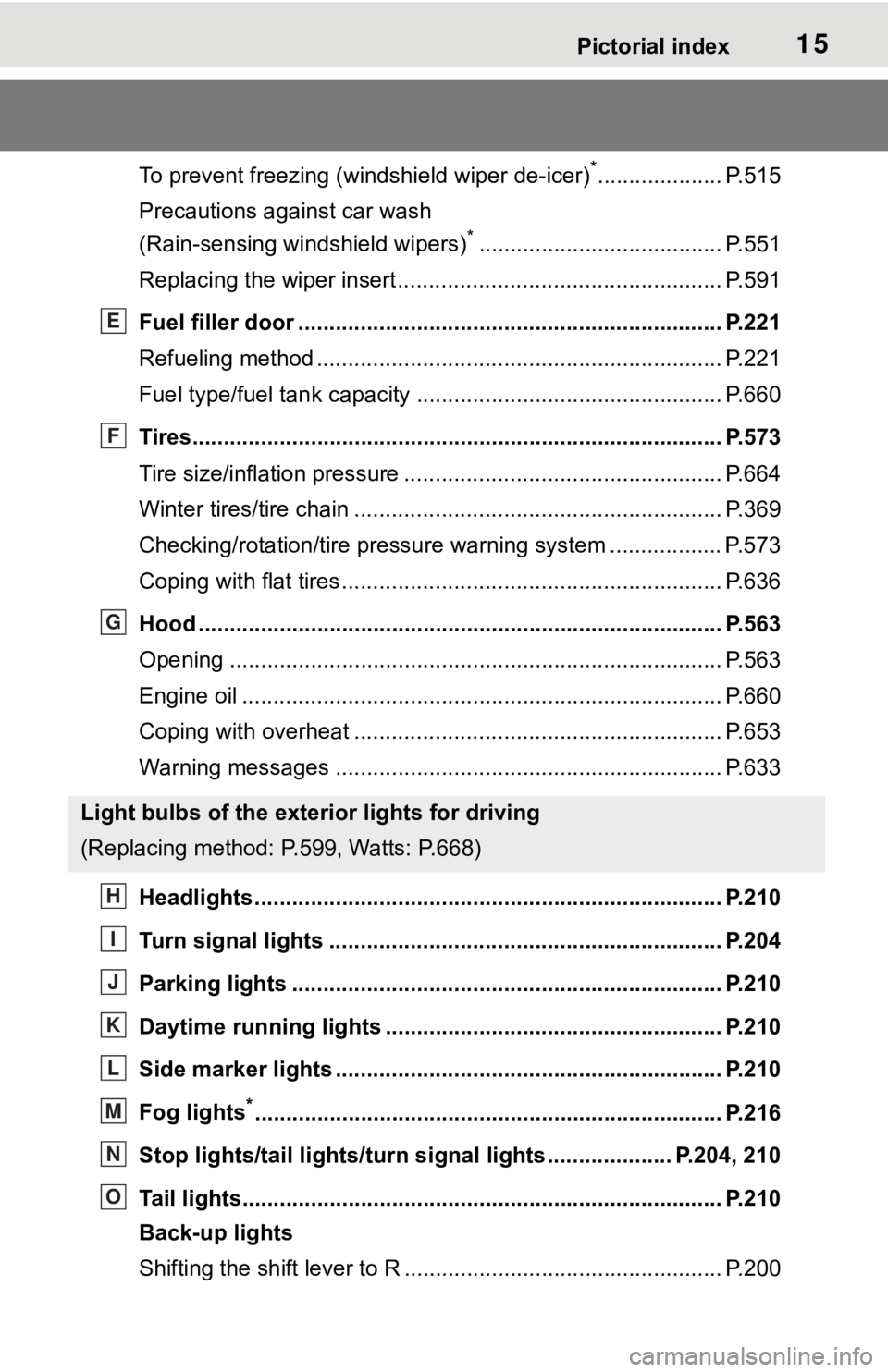
15Pictorial index
To prevent freezing (windshield wiper de-icer)*.................... P.515
Precautions against car wash
(Rain-sensing windshield wipers)
*....................................... P.551
Replacing the wiper insert ..................................... ............... P.591
Fuel filler door ............................................... ..................... P.221
Refueling method ............................................... .................. P.221
Fuel type/fuel tan k capacity ................................... .............. P.660
Tires.......................................................... ........................... P.573
Tire size/inflation pressure ................................... ................ P.664
Winter tires/tire chain ........................................ ................... P.369
Checking/rotation/tire pressur e warning system ..................P.573
Coping with flat tires......................................... .................... P.636
Hood ........................................................... ......................... P.563
Opening ............................................................................... P.563
Engine oil ..................................................... ........................ P.660
Coping with overheat ........................................... ................ P.653
Warning messages ............................................... ............... P.633
Headlights..................................................... ...................... P.210
Turn signal lights ............................................. .................. P.204
Parking lights ................................................. .................... P.210
Daytime running lights .. .................................................... P.210
Side marker lights ............................................. ................. P.210
Fog lights
*............................................................... ............ P.216
Stop lights/tail lights/turn s ignal lights .................... P.204, 210
Tail lights.................................................... ......................... P.210
Back-up lights
Shifting the shift lever to R ................................................... P.200
Light bulbs of the exterior lights for driving
(Replacing method: P.599, Watts: P.668)
E
F
G
H
I
J
K
L
M
N
O
Page 204 of 728

2044-2. Driving procedures
1Right turn
2 Lane change to the right
(move the lever partway and
release it)
The right hand signals will flash 3
times.
3Lane change to the left
(move the lever partway and
release it)
The left hand signals will flash 3
times.
4Left turn
■Turn signals can be operated
when
The engine switch is in ON.
■If the indicator flashes faster
than usual
Check that a light bulb in the front or
rear turn signal lights has not burned out.
■If the turn signals stop flashing
before a lane change has been
performed
Operate the lever again.
■To discontinue flashing of the
turn signals during a lane
change
Operate the lever in the opposite
direction.
Tur n signal lever
Operating instructions
Page 549 of 728

549
7
7
Maintenance and care
Maintenance and care
7-1. Maintenance and careCleaning and protecting the vehicle exterior .......... 550
Cleaning and protecting the vehicle interior ........... 553
7-2. Maintenance Maintenance requirements.................................. 556
General maintenance.. 557
Emission inspection and maintenance (I/M) pro-
grams ........................ 560
7-3. Do-it-yourself mainte- nance
Do-it-yourself service pre- cautions ..................... 561
Hood ........................... 563
Positioning a floor jack 564
Engine compartment ... 566
Tires ............................ 573
Tire inflation pressure.. 585
Wheels ......... ...............587
Air conditioning filter .... 589
Wiper insert replacement .................................. 591
Wireless remote con- trol/electronic key battery.................................. 594
Checking and replacing fuses.......................... 597
Light bulbs................... 599
Page 562 of 728

5627-3. Do-it-yourself maintenance
Light bulbs
( P.599)
• Bulb with same
number and watt-
age rating as origi-
nal
• Phillips-head screwdriver
• Flathead screw- driver
•Wrench
Radiator and
condenser
( P.569)
Tire inflation
pressure
( P.585)• Tire pressure
gauge
• Compressed air source
Washer fluid
( P.572)
• Water or washer
fluid containing
antifreeze (for win-
ter use)
• Funnel (used only for adding water or
washer fluid)
WA R N I N G
The engine compartment contains
many mechanisms and fluids that
may move suddenly, become hot,
or become electrically energized.
To avoid death or serious injury,
observe the following precautions.
■When working on the engine
compartment
●Keep hands, clothing and tools
away from the moving fan and
engine drive belt.
●Be careful not to touch the
engine, radiator , exhaust mani-
fold, etc., right after driving as
they may be hot . Oil and other
fluids may also be hot.
ItemsParts and tools●Do not leave anything that may
burn easily, such as paper and
rags, in the engine compart-
ment.
●Do not smoke, c ause sparks or
expose an open flame to fuel or
the battery. Fuel and battery
fumes are flammable.
●Be extremely cautious when
working on the battery. It con-
tains poisonous and corrosive
sulfuric acid.
■When working near the elec-
tric cooling fan or radiator
grille
Be sure the engine switch is off.
With the engine switch in ON, the
electric cooling fa n may automati-
cally start to run if the air condi-
tioning is on and/or the coolant
temperature is high. ( P.569)
■Safety glasses
Wear safety glasses to prevent
flying or falling material, fluid
spray, etc., from getting in your
eyes.
NOTICE
■If you remove the air cleaner
filter
Driving with the ai r cleaner filter
removed may cause excessive
engine wear due to dirt in the air.
Page 598 of 728
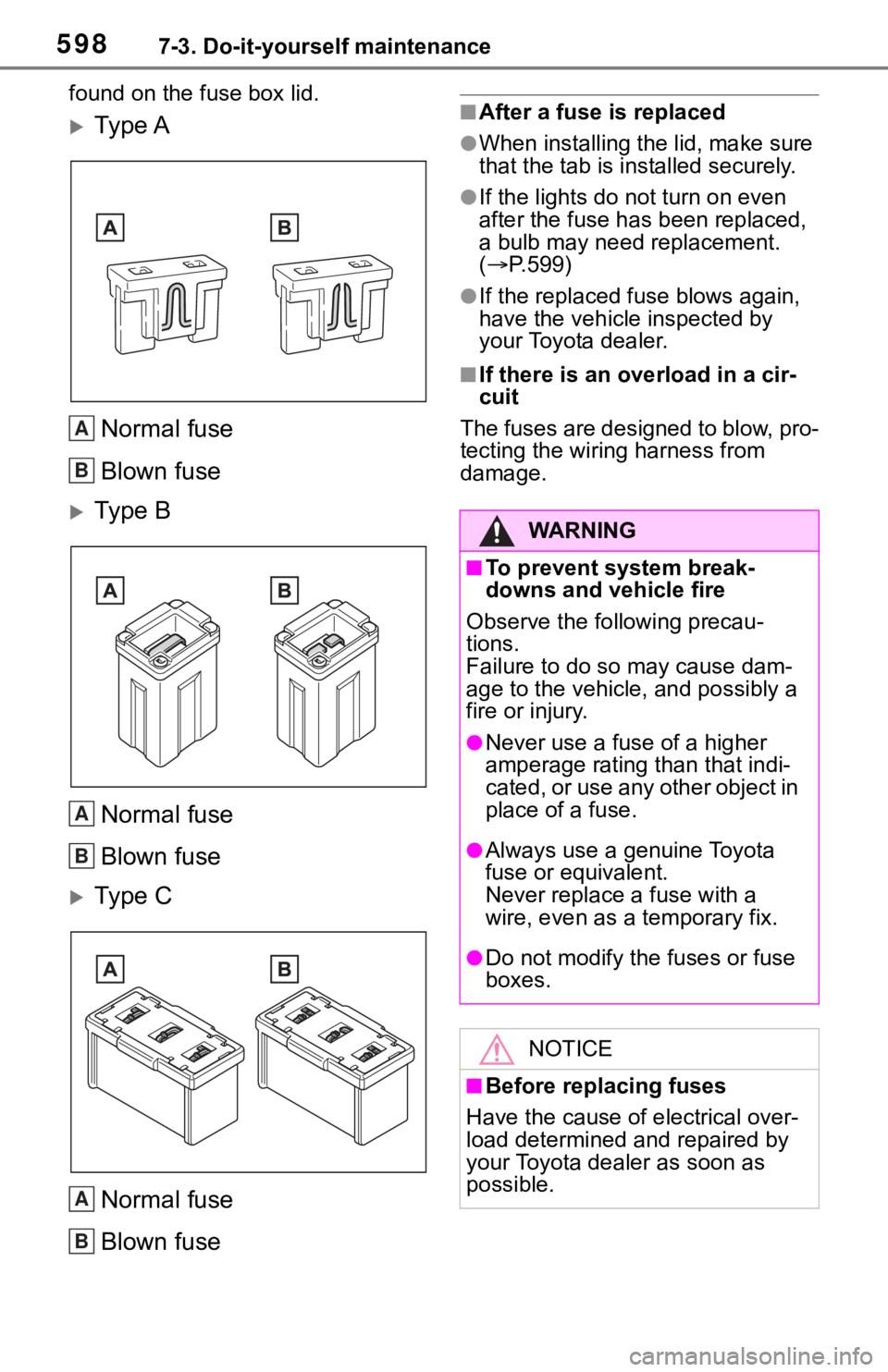
5987-3. Do-it-yourself maintenance
found on the fuse box lid.
Ty p e A
Normal fuse
Blown fuse
Ty p e BNormal fuse
Blown fuse
Ty p e CNormal fuse
Blown fuse
■After a fuse is replaced
●When installing the lid, make sure
that the tab is ins talled securely.
●If the lights do not turn on even
after the fuse has been replaced,
a bulb may need replacement.
( P.599)
●If the replaced fuse blows again,
have the vehicle inspected by
your Toyota dealer.
■If there is an ove rload in a cir-
cuit
The fuses are designed to blow, pro-
tecting the wiring harness from
damage.
A
B
A
B
A
B
WA R N I N G
■To prevent system break-
downs and vehicle fire
Observe the following precau-
tions.
Failure to do so may cause dam-
age to the vehicle, and possibly a
fire or injury.
●Never use a fuse of a higher
amperage rating than that indi-
cated, or use any other object in
place of a fuse.
●Always use a genuine Toyota
fuse or equivalent.
Never replace a fuse with a
wire, even as a temporary fix.
●Do not modify the fuses or fuse
boxes.
NOTICE
■Before replacing fuses
Have the cause of electrical over-
load determined and repaired by
your Toyota dealer as soon as
possible.
Page 599 of 728

5997-3. Do-it-yourself maintenance
7
Maintenance and care
Check the wattage of the light
bulb to be replaced. (P.668)
Front (type A)
Front turn signal/parking
lights
Fog lights (if equipped)
Front side marker lights
Outer foot lights (if equipped)
NOTICE
■To prevent damage to the
engine compartment fuse box
cover
When opening the fuse box, com-
pletely release the claw locks
before lifting up the cover. Other-
wise, the claws may be damaged.
Light bulbs
You may replace the follow-
ing bulbs by yourself. The
difficulty level of replace-
ment varies depending on
the bulb. As there is a dan-
ger that components may
be damaged, we recom-
mend that replacement is
carried out by your Toyota
dealer.
Preparing for light bulb
replacement
Bulb location
A
B
C
D
Page 601 of 728
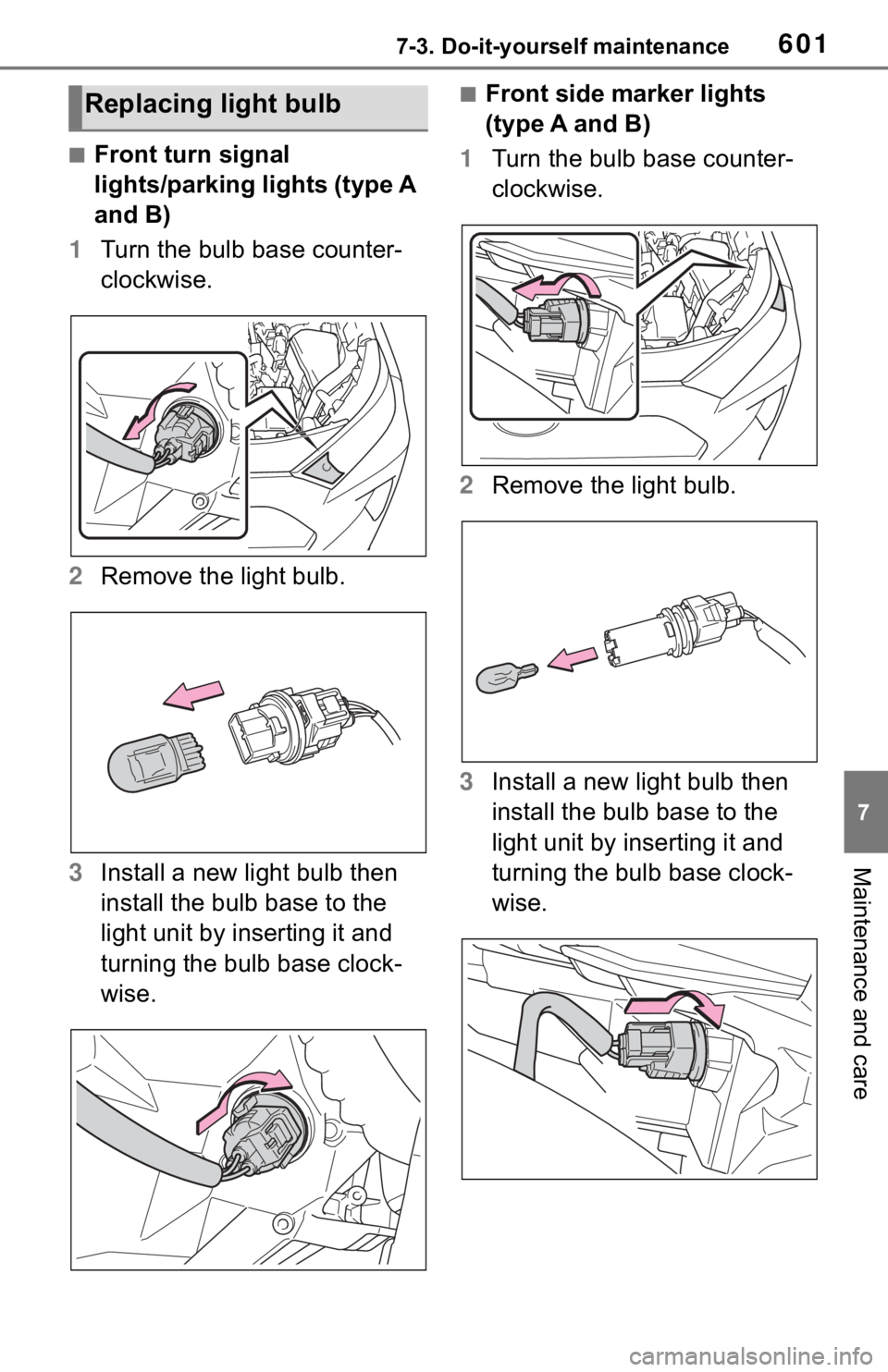
6017-3. Do-it-yourself maintenance
7
Maintenance and care
■Front turn signal
lights/parking lights (type A
and B)
1 Turn the bulb base counter-
clockwise.
2 Remove the light bulb.
3 Install a new light bulb then
install the bulb base to the
light unit by inserting it and
turning the bulb base clock-
wise.
■Front side marker lights
(type A and B)
1 Turn the bulb base counter-
clockwise.
2 Remove the light bulb.
3 Install a new light bulb then
install the bulb base to the
light unit by inserting it and
turning the bulb base clock-
wise.Replacing light bulb
Page 602 of 728
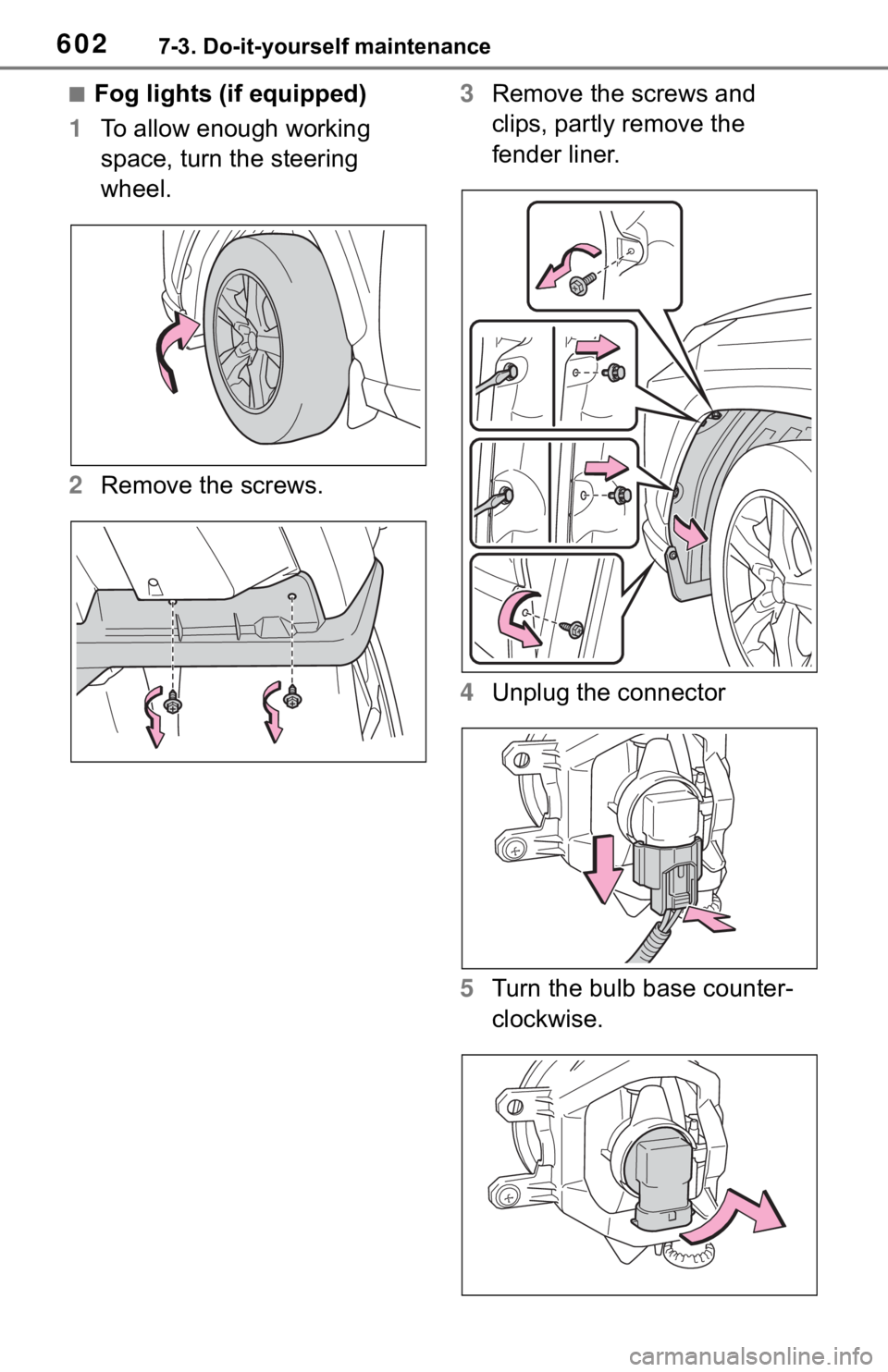
6027-3. Do-it-yourself maintenance
■Fog lights (if equipped)
1 To allow enough working
space, turn the steering
wheel.
2 Remove the screws. 3
Remove the screws and
clips, partly remove the
fender liner.
4 Unplug the connector
5 Turn the bulb base counter-
clockwise.